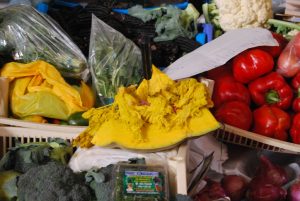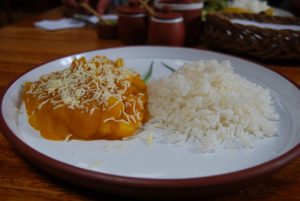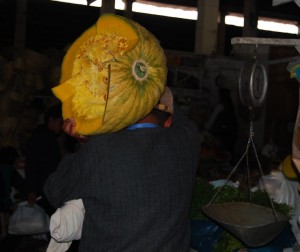Cuzco’s Native Squash, Zapallo, Excites Its People

Long slices of bright orange or yellow from an enormous winter squash, called zapallo (suh-pie-yoh), always occupy the stands of Cuzco’s markets and supermarkets. The word comes from the Quechua zapallu and the squash is one of the staples of Cuzco.
In the area of Peru many plants and animals were domesticated that now are very important in throughout the world. Squash was cultivated in Peru as early as 10,000 years ago and has been important ever since. As a result there are lots of local varieties.
One of them, the loche squash from the north coast of Peru has received official recognition with a “denominación de origen” (a designation of origin). Loche is from the cucurbita moschata species and is different from the zapallo of Cuzco which is probably cucurubita máxima.

C. maxima is one of the most diverse and widespread of squash species. Though it originated in South America it spread to North America and there developed in squashes such as the banana squash, hubbard squash. The famous Japanese kabocha squash also is a c. maxima.
Our zapallo is distinctive in its own right. Though it varies somewhat from farmer to farmer it has its own distinctive characteristics. First of all, the zapallo is huge, often being some fifteen inches to two feet in diameter. It has a spherical form which is somewhat elongated. It never has a curve or a narrow neck. The surface can be either smooth or wrinkled. The external surface is generally green in color although it can also have white on it. But inside the color is a sharp orange or yellow. Though its outer skin is very tough, its flesh is soft.

In our cooking the zapallo is used for various dishes. Perhaps the most famous is the locro of zapallo con queso. This is a plate of rice accompanied by a puree of stewed zapallo and potato decorated with grated cheese. It is delicious. Zapallo is also found in soups, especially in our chairo and our morón (barley) soup.

Zapallo can be purchased in the different markets of our city. It can be bought whole or divided into parts. Vendors weigh it and charge by weight. Zapallo is very economical and as a result it is widely used in Cuzco’s homes to produce food so delicious you lick your fingers.
When I was a boy I would go with my mother to help with her Sunday purchases in the market. She would always buy zapallo to make a locro. I still love that dish even today.
My mother would give us the seeds to let them dry in the sun. When they were well sunned and dry, she would toast them delicately without burning a single seed. In the meantime she would prepare cones of paper.

She would fill the cones with the toasted seed. We would peel them and take out the seed inside. Sometimes my brothers, sister, and I would compete to see who could peel the most. But the best part was next. We got to eat all the toasted squash seeds. They have a very distinctive taste somewhat like roasted peanuts.
My mother always said that if we would eat the seeds it would help keep us from getting a cough or a cold.
Not only is zapallo understood to have this health effect, it is a wonderful food and is one of the basic foods of our Cuzco.




